The Phottix Mitros and Nissin Di866 Mark II flashes are the top-of-the-line offerings from the established third-party manufacturers. They both offer impressive sets of features coming very close and, in certain areas, surpassing the flagship units from Canon and Nikon (See our Phottix Mitros review and Nissin Di866 II vs Canon 580EX II comparison, for example). Having similar price points, these flashguns are the obvious competitors. So, in this review, we are going to look at the differences in detail, which should help you to pick the one that is right for your photography applications.
Please note that Nissin makes Di866 II for Canon, Nikon, and Sony cameras, whereas Mitros is currently only available for Canon and Nikon. For this review, we tested the Canon models of both flashes.
Both, Mitros and Di866 II, are very well built. The construction quality is very good. The flashes are similar in weight and size, though Mitros is larger. It is hard to recommend one over another in terms of quality, because both units feel solid and have served us well so far.
Both flashguns offer a set of features to fit the needs of professional photographers. It includes TTL, Manual and Stroboscopic modes, master and slave TTL capabilities, high-speed and second curtain sync, flash bracketing, AF-assist beam, USB port for firmware updates, etc.
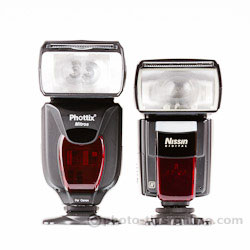 |
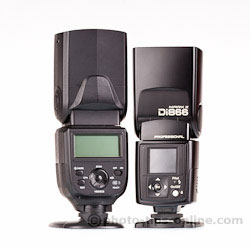 |
At 105mm zoom and ISO 100, Nissin Di866 II has a Guide Number of 60, whereas Phottix Mitros is rated to have a Guide Number of 58. So, the difference should be about 1/10th of a stop. However, in our measurement tests, Phottix Mitros was putting out between 1/3- and 1/2-stop less light.
The recycling time is important for fast-paced photography applications. In our tests, it tookDi866 II about 4.8 seconds on average to recycle at full power. The Mitros speedlight was recycling at blazing 2.2 seconds. Let's not forget, however, that at the maximum power, the Nissin flash produces more light, so it is normal for a more powerful flash to recycle longer to get fully charged. To make the comparison fair, we dialed Di866 II down to get closer to the light output of the Phottix flash. As a result, the recycling time was reduced to about 2.7 seconds. So, at the similar power levels, the difference in recycling time is not that big, though Mitros still has the edge here.
Like most speedlights, Di866 II and Mitros can overheat when fired in rapid successions at full power. It normally happens after 20-30 pops. The ways these flashes handle overheating are different, however. Nissin Di866 II simply seizes the operation until the internal temperature returns to an acceptable level (usually after a few minutes). Phottix Mitros employs a different technology and starts slowing down recycling to spread the consecutive fires further apart. At first sign of overheating, the recycling time goes up to 4-5 seconds, but if you keep on firing, Mitros will increase it to 20 seconds and more. The second approach is usually preferable, because it allows you to keep on firing longer, but not at the same pace. In any case, it is recommended to let a speedlight cool down and not to push it too hard.
The user interface is probably where you can find quite a few differences between these two flashes without even trying. Phottix Mitros features a large LCD with intuitive menus. There is a number of dedicated buttons (for quick access) like, for example, Mode, Zoom, and HSS (high-speed sync). The D-pad allows to navigate the menus and change the parameter values. If you are new to flash photography, there is some learning curve here, but it's not very different from what you would have to go through with Canon or Nikon units. If you used a flash before, you'd figure out the Phottix menus in no time.
Nissin is currently the only brand that offers color LCD's in its flashes. The colors are not just there for the fun of it; they can improve the efficiency of your photography workflow. All modes of the Nissin flash are color-coded, so it's easier to distinguish them at a glance.
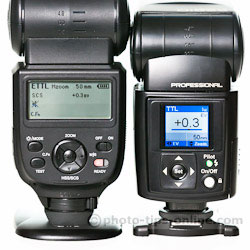 |
 |
Also, Nissin takes a very different approach to the menu structure. The general idea is to show the most important parameters in the main menu, so it is less cluttered. This design also makes the flash easier to use for novices. As the flip side of it, some of the functions are placed one level deeper, so to change the high-speed sync setting, for instance, you need to enter a separate menu of advanced parameters.
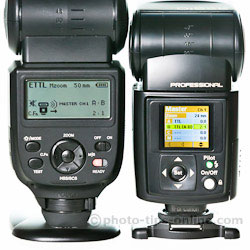 |
The square screen and the D-pad of Di866 II are designed to allow the photographers to control the flash comfortably regardless of whether the unit is positioned vertically or sideways. When your camera is in the portrait orientation, the menu rotates 90 degrees and the D-pad swaps the behavior of the arrows (up and down arrows become left and right ones, and vice versa). This is a unique feature that can be handy not only when shooting with the flash on camera, but also when using it off-camera, as well (in many off-camera setups the flash is positioned sideways).
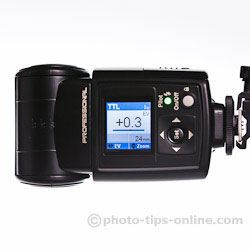 |
Nissin Di866 II speedlight also has a handy feature of locking the controls. By simply pressing the power button, you can lock and unlock the D-pad, so you don't accidentally change the settings when, for example, using the flash handheld.
 |
Phottix Mitros does not have the control lock, but it offers another useful feature that the Nissin units lacks – battery level indicator. Knowing the battery charge level can be critical for certain applications. For example, instead of stopping in the middle of a photo session to change the batteries because the flash does not fire (or it takes way to long to recycle), you can keep an eye on the indicator and find a moment to do a "planned" battery swap without the client even noticing.
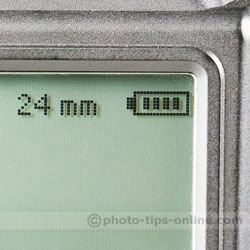 |
Both, Mitros and Di866 II, have a zoom range from 24 mm to 105 mm, but with the built-in wide-angle diffuser, Mitros covers up to 14 mm frame, whereas Di866 II can only go as wide as 18 mm.
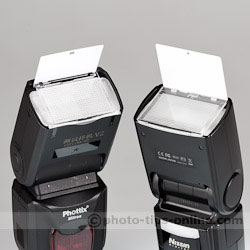 |
Another advantage of the Phottix flash head is that the flash rotates full 180 degrees to the left and right. The Nissin unit is limited to 90 degrees to the left, while it also goes 180 degrees to the right. Depending on your flash bouncing techniques, it can sometimes become a problem. However, to be fair, many photographers will be fine with this limitation, but we still prefer the freedom of being able to rotate the flash head any way we want.
Additionally, Mitros can tilt down 7 degrees to provide some aid for macro shots.
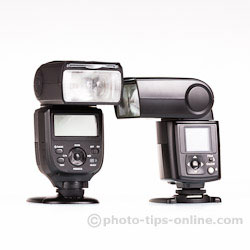 |
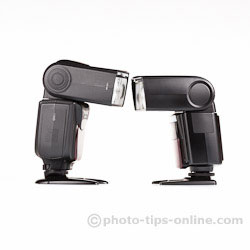 |
Some flashes have very loud zoom motors, but Di866 II and Mitros keep the noise at very reasonable levels when zooming from one position to another. We have to add, though, that Nissin Di866 II has one of the quietest zoom motors on the market, and it is noticeably quieter than Mitros. So, if you often shoot in places where it's important to attract as little attention as possible (like, for instance, in churches), Di866 II might be a better fit.
Many today's cameras allow you to control the attached flash via the camera menus. We found that Phottix Mitros supports almost every single feature via the in-camera menus, including most of the custom functions. Nissin Di866 II supports very few features via the camera menus, and it is also can be flaky at times. So, we would go as far as saying that it might not be practical to use in-camera flash controls with the Nissin flashgun, and stick to its LCD, which quite intuitive to use, anyway. So, if you prefer controlling your flash via in-camera menus, Mitros is a better choice for that.
Nissin Di866 II features a second flash tube located in its body. It allows you to throw some light forward, while pointing the flash head elsewhere. The secondary flash can come in handy for creating fill light when bouncing light from the main tube off of the walls (in this case, the built-in catchlight card cannot be used). You can refer to Metz 58 AF-1 test to get a feel for how the sub-flash can perform. The secondary flash works in both, TTL and manual modes, but its output is set manually from 1/1 to 1/128th of its power.
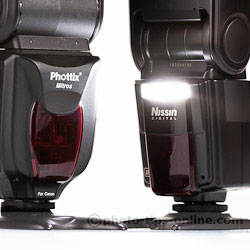 |
If you use manual radio triggers, you need to be able to connect them to your flash. PC sync has been a standard for that for many years, and that is what Nissin Di866 II offers. However, PC sync cords are often criticized by pro photographers, so Phottix went the route of replacing the PC sync socket with a miniphone port, which is usually more reliable. So, depending on your preferences and existing equipment, you need to consider that these two flashes offer different sync ports.
 |
As far as TTL radio triggers go, Nissin Di866 II worked perfectly in our tests with PocketWizard FlexTT5 transceivers, while Mitros was not able to play along with PW's at all. Obviously, Mitros does work with the Phottix's own Odin TTL triggers, which is an alternative to the PocketWizard radios.
There are few other differences between the Mitros and Di866 II flashes that are worth mentioning. For example, Mitros has a quick release hot-shoe lock, whereas Di866 II employs a mounting ring.
Both units offer a "dumb" optical slave mode, in which the flash is triggered by a burst of light from a manual speedlight or a studio strobe. In addition, Di866 II offers an optical slave mode which ignores the TTL pre-flashes, so the unit can be triggered by a TTL speedlight of a different brand.
Nissin Di866 II features a battery magazine, which allows to swap the batteries faster if you have another magazine pre-loaded with a set of batteries.
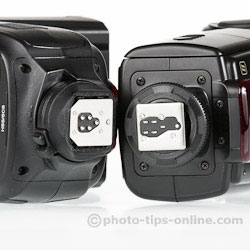 |
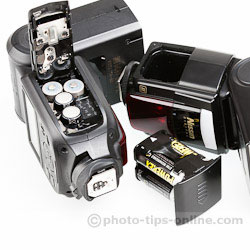 |
To connect a Canon power pack, Phottix Mitros requires an adapter (which is included with the flash). The Nissin unit has a standard Canon socket.
Another minor difference is the maximum stroboscopic frequency. Phottix Mitros can go as high as 199Hz, which is the double of the Nissin's maximum frequency.
Phottix Mitros comes with arguably the best carrying pouch on the market. The pouch has a lot of padding, many pockets, belt clip/loop, side loops and even a hanging loop. Mitros also comes with a diffusion dome, miniphone sync cable, USB cable, flash stand, and a USB memory stick, which contains the instruction manual.
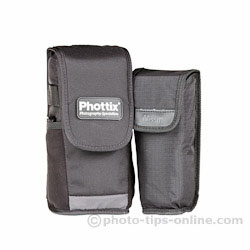 |
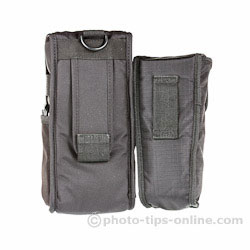 |
 |
 |
Nissin Di866 II is being shipped with a flash stand and a case. The case is fairly thin with not much padding, so the main purpose of it would be to protect from scratches and keep the stand with the flash. On the positive side, the case is very compact and lightweight, which is a plus when used on a belt.
To summarize, it's hard to go wrong with any of these flashes. They both target professional photographers, as well as photography enthusiasts. The highlights of the Nissin Di866 II flash are the higher maximum power, color-coded rotating menus, secondary flash, additional optical slave mode, compatibility with PocketWizard, and the unique battery magazine. Phottix Mitros offers faster recycling, high compatibility with in-camera controls, better bouncing capabilities, quick release lock, and premium accessories.